
HartRAO Home >
news >
Venus transits the Sun 2004/06/08
Venus transits the Sun 2004/06/08
On 2004 June 8, Venus passed in front of the Sun for the first time since
1882. Historically, these "Transits of Venus" were of great importance, as
they enabled the size of the solar system to be measured. Today this is
done using radar. However it is possible for individuals across most of
Africa to make simple observations of this transit and so establish for
themselves the size of the solar system. This made it a valuable
educational exercise.
Most HartRAO staff observed the transit from the observatory, while three
staff members assisted with the mass public viewing at the much more
accessible Johannesburg Planetarium.
Pictures
of the transit from the Johannesburg Planetarium.
Venus transit at Hartebeesthoek
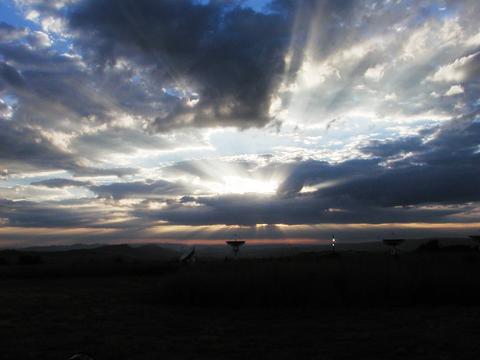
Left click on image for large version [S Goedhart]
The weather over the Hartebeesthoek Radio Astronomy Observatory at the start
of the transit was not auspicious. A cold front was passing over, bringing
rapidly moving low cloud. The image above was taken one minute before first
contact.
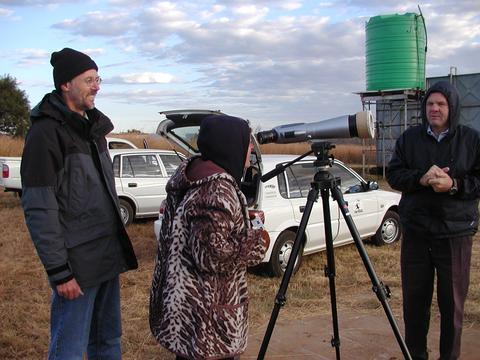
Left click on image for large version [S Goedhart]
Just after first contact, astronomer Marion West views the Sun through the
spotting scope equipped with a solar filter, while astronomer Mike Gaylard,
on the left, and SLR manager Wilhelm Haupt look on.
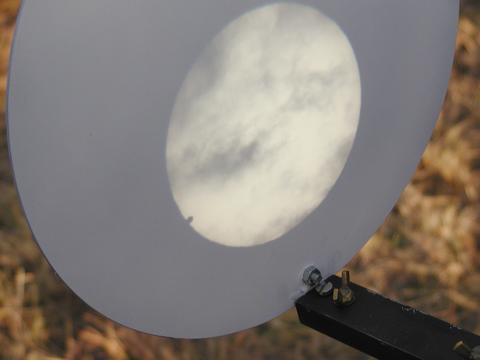
Left click on image for large version [S Goedhart]
Projected image of the Sun just before second contact.

Left click on image for large version [M Gaylard]
At Hartebeesthoek, the transit was viewed
using eclipse viewers, with a spotting scope fitted with a solar filter, and
by projection using a 10cm Meade telescope, as shown above.
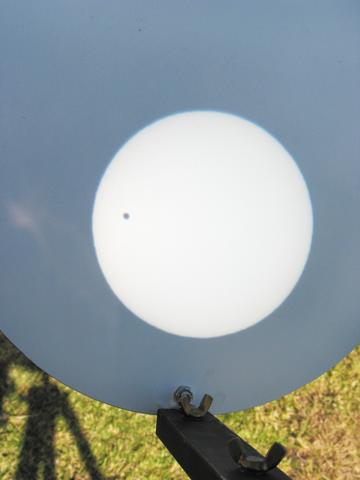
Left click on image for large version [M Gaylard]
A close-up image of Venus transiting the Sun is shown above. The image is
reversed by the telescope, so Venus appears on the left, whereas by direct
viewing it appeared on the right from this site at the beginning of the
transit. First contact occurred at the "four o'clock" position on the Sun
as seen from here. Low clouds accompanying a cold front obscured much of
the start of the transit, but a fortuitous gap in the clouds enabled the
Hartebeesthoek observers to time second contact at 07h 36m 05s SAST (UT+2h).
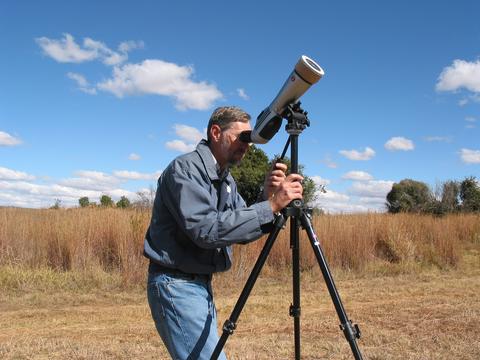
Left click on image for large version [M Gaylard]
Contact timings were made by the author using this Leica Televid 77 spotting
scope equipped with Baader solar filter. Here third contact is about to
occur, timed at 13h 10m 00s SAST.

[S Goedhart]
Close-up of projected image around third contact. Note that there is
uncorrected chromatic aberration in the eyepiece, producing distinctly
offset image at the red and blue ends of the spectrum, making timing
difficult by this method.

And the transit is nearly over.
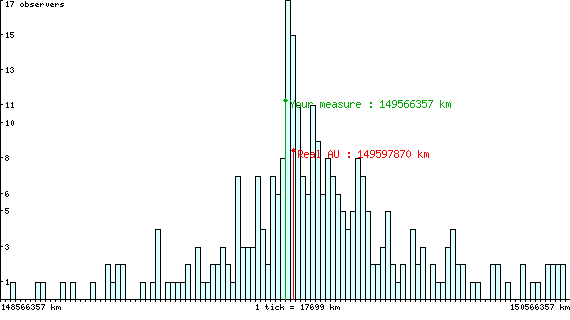
The timing results were submitted to the European Southern Observatory (ESO)
Venus Transit website (see below). The plot above of the result compared to
others submitted is from the observers page at the VT-2004 Observation
Campaign, but see also the results on the ESO website. The value in green
above is that derived from the Hartebeesthoek measurements.
HartRAO staff astronomer Sarah Buchner and educators Daphne Kedibone
Lekgwathi and Mzi Taele helped run the mass viewing of the transit
from the Johannesburg Planetarium, which was attended by hundreds of
learners and public.
Background to the Venus Transit
It was possible to watch the transit using the same methods used to watch
the recent total eclipses of the Sun. These methods included:
- Using eclipse viewers
- Projecting an image of the Sun onto a white surface, by using
binoculars or a small telescope
The same safety precautions applied as for a solar eclipse:
- DO NOT look directly at the Sun with the unaided eye or through dark glasses
- DO NOT look directly at the Sun through binoculars or a telescope
Looking at the Sun in either of these ways can damage your eyes permanently.
Venus appeared as a small black dot passing across the face of the Sun.
The angular diameter of the Sun is 30 minutes of arc (= 0.5 degrees), while
the angular diameter of Venus will just under 1 minute of arc (this changes
as the distance of Venus from the Earth changes). Hence the diameter of
Venus during the transit will appear to be 3 % of the diameter of the Sun.
To make useful measurements we needed:
- To know our geographic location to within 1-2 km. A GPS receiver was
used to do this, otherwise we could refer to accurate maps.
- To be able to measure the times of second and third contact (described
below) to an accuracy of 1 second.
There are four 'times of contact':
- First contact (contact I) -
The edge of the disk of Venus first touched
the edge of the disk of the Sun (at approximately 07h 17m SAST in
Johannesburg). Venus was not be visible until this moment.
- Second contact (contact II) -
The edge of the disk of Venus just broke
contact with the edge of the disk of the Sun, so that Venus appears fully
inside the Sun's disk (at approximately 07h 36m SAST in
Johannesburg)
- Third contact (contact III) -
The edge of the disk of Venus just
touched the edge of the disk of the Sun, on its way out (at approximately
13h 10m SAST in Johannesburg)
- Fourth contact (contact IV) -
The edge of the disk of Venus broke
contact with the edge of the Sun and Venus is lost to sight (at
approximately 13h 28m 44s SAST in Johannesburg)
How use was made of these measurements is described in the links below.
Links
Several excellent websites were set up that cover this event.









